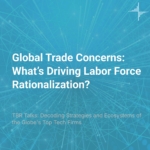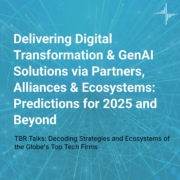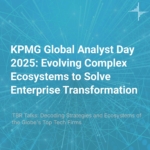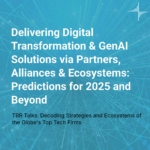Global Trade Concerns: What’s Driving Labor Force Rationalization?

In this episode of “TBR Talks,” Principal Analyst Boz Hristov and Senior Analyst Kelly Lesiczka join Patrick for a discussion on the challenges occurring amid reductions in force and labor rationalization across the global tech marketplace.
The pair, who specialize in digital transformation, ecosystems and management consulting research, also look at the trends and predictions TBR’s teams noted in 2023 and continue to observe in 2025 regarding anticipated reduction in and optimization of the labor pyramid within professional services and IT services vendors.
Listen and learn with TBR Talks!
Submit your Key Intelligence Questions for Patrick and his guests
Connect with Patrick on LinkedIn:
Connect with Kelly on LinkedIn
Connect with Boz on LinkedIn
Learn more about TBR at https://tbri.com/
TBR Talks is produced by Technology Business Research, Inc.
Edited by Haley Demers
Music by Burty Sounds via Pixabay
Art by Amanda Hamilton Sy
Global Trade Concerns: What’s Driving Labor Force Rationalization?
TBR Talks Host Patrick Heffernan: Welcome to TBR Talks: Decoding Strategies and Ecosystems of the Globe’s Top Tech Firms, where we talk business model disruption in the broad technology ecosystem, from management consultancies to systems integrators, hyperscalers to independent software vendors, telecom operators to network and infrastructure vendors and chip manufacturers to value added resellers. We’ll be answering some of the key intelligence questions we’ve heard from executives and business unit leaders among the leading professional IT services and telecom vendors.
I’m Patrick Heffernan, Principal Analyst, and today we’ll be talking about the potential labor pyramid collapse with Boz Hristov, Principal Analyst for TBR’s Digital Transformation practice, and Kelly Lesiczka, Senior Analyst for TBR’s Professional Services practice.
Kelly and Boz, welcome back to the TBR Talks podcast. Great to see you both.
Bozhidar Hristov, TBR Principal Analyst: You as well.
Shifted thinking around the potential labor pyramid collapse
Patrick: What we want to talk about today is something we’ve been talking about for two years now, which once generative AI became the biggest story of 2023 early on, and once we started to understand how the companies that we cover. So, the IT services companies and the consultancies, once we thought about how they were going to adopt generative AI and some of the use cases that they would use internally, we started imagining a collapse of the traditional labor pyramid. That is, rather than having to hire lots of people at an entry level and use an apprentice model in the consulting world and just use a sort of up and out model in the IT services world. And have those people eventually get whittled down to that top of the pyramid. Instead, the sort of two sides of the pyramid would evaporate, because you could use generative AI to do so much of that entry level kind of work. That was our thinking in 2023, and I would say we still are thinking in 2024 now, early mid 2025, what are we thinking? Are we seeing that coming to bear or is it something different. Boz, I’ll let you go first.
Boz: Sure. I think you use a very interesting word, imagine, right. When it came to what we were anticipating that may be happening in the world of professional services, professional IT services. So, the ebbs and flows of the headcount distribution for all the IT service and professional services vendors, is not a new phenomenon. We saw a lot of those, and all that anticipation and back in, 5 or 7 years ago when RPA first came around and obviously the AI and the GenAI has put a little bit more of a pressure and it’s pressure testing the employee pyramids of many of the IT services and consultancies. But I think before any of that can happen, I think what many of those vendors have been experiencing in the last 24 to 30 months, has been they came off the high hiring and recruiting after the pandemic. Right. So, everyone pretty much up there, recruiting and increasing their headcount, 25%/30%. The demand, though, started to cool off much sooner, much faster than, you know, than anyone was anticipating. So, what we saw in late 2023 and through 2024 was a decline in headcount. And that was actually- we track the headcount distribution as part of our Global Delivery Benchmark. And this benchmark has been going on for over the last 15+ years. And that was the first time we saw the companies that were within the benchmark, the average headcount contracting, which kind of gave an indication. Okay, is this the moment, an inflection point in time when vendors will actually look into their business models and try to look into their headcount a little bit through a different lens? And so, trying to answer the question was are those companies reducing the headcount as a result of AI because they’re starting to feel the pressure of AI, or because the demand was slowing down. Our initial indication and estimates are suggesting that the decline in headcount was largely because of slower demand, less of AI. If we had to put a number behind, probably no more than 10% to 15% of the headcount decline was a result of AI pressure. The other 80%/85%+ was as a result of slower demand and vendors just being, you know, over hiring. Now fast forward into 2025, we start to see in the late in the 3Q and the 4Q in 2024, actually, which is the numbers have been reported in the first quarter into 2025, vendors are starting to hire back again which suggests again, that that anticipation and imagination in terms of like where those companies labor pyramids are maybe going to look like, was just a temporary blip. For most vendors, some vendors are still kind of in that adjustment mode, and they’re trying to think about what it all means to them moving forward. I think the net new additions in the late 2024, early 2025 are largely because there was an uptick in signings in early 2024, in large and mega deals for a lot of the IT outsourcing companies and as we know, those types of contracts, typically the revenue recognition cycle takes a little bit longer than the traditional consulting model. So, there’s been that kind of a delay in hiring. But certainly, when there’s a start to hiring back again. Now, will they hire at the same pace as they were doing in 2021, 2022, 2023? Probably not. They are very careful. They are very strategic in terms of who they hire, and how they’re hiring, in terms of the scale of it. Acquisitions still remain a piece of the puzzle, allowing vendors to get the more on-demand skills as well as capture new business that way along the way. So, bottom line, the decline has rebounded. And I think, certainly will pressure test again. You know, those company’s business models moving forward because now we’re starting to see actually, AI and GenAI kind of picking up. So, we’ll start to see how much that will impact actually their hiring plans and into late 2025 and 2026.
Patrick: So, Kelly, I’ll come to you on the management consultancies. But first, a couple clarifications, Boz.
Boz: Yeah.
Patrick: So, when you talked about the headcount decline, what was striking about it was the growth was still happening for those- revenue growth was still happening. So, there was a real disconnect there between the two, right?
Boz: Initially there was, that was the anticipation when they were hiring at such a pace. But the demand started to slow down, the demand for consulting work,
Patrick: Right.
Boz: I should say that to be more specific. The demand for consulting work really cooled off, and the demand for consulting work, which needs like an immediate excuse to be deployed for ad hoc projects, kind of cooled off. And those companies had really over-hired essentially because there was such a high demand for consulting in the 2021, 2022 period. So, it’s starting in 2022, 2024. You know, the demand for consulting cooled off, largely because AI started to come around.
Patrick: Right.
Boz: So, there was that, you know, pivotal discussion between the demand for consulting versus demand for IT outsourcing services.
Could the collapse still happen?
Patrick: So, you made a point though, that the AI adoption is accelerating now. So, is it possible that our read, our analysis of what was happening in 2023 and the collapsing of the pyramid that we were predicting was simply two years too soon?
Boz: It is possible. It is possible, you know, what is the first phrase a dead cat bounce, you know, from a headcount perspective.
Patrick: Yeah.
Boz: Yeah. So, we could be experiencing some of that. And I think some of the vendors, they’re a little bit more- the less tech heavy, the less offshore heavy, I should say. They might be a little better positioned. Just thinking about, you know, how they’re thinking and positioning their portfolio. But then again, I don’t think most of the vendors will say no to IT outsourcing work, regardless of how much demand AI is in, and yes demand for AI is picking up. But the actual revenue, the actual dollars, the hard dollars, are much smaller in terms of the award size than traditional IT outsourcing.
Patrick: Right. And so, then the margins are not as good because you-
Boz: I would say margins are on par right now with the traditional IT services and they’re no- they’re not bigger. So, you have a smaller scale awards with the same margin. So, you need to kind of start thinking about different ways and whether you, you know, deploy and mobilize your resources. What actually you make good profit.
Could the management consultancy’s labor pyramids collapse?
Patrick: Right. So, Kelly, from your perspective, looking at a lot of the management consultancies, do you think there’s going to be that collapse of the pyramid and that maybe we’re just two years ahead of ourselves on this? And I’m thinking in particular about the Big Four firms and the McKinsey, Bain and BCG that really do have that apprenticeship model where they need to hire lots of people at an early part in their career, so they can either build them up to be a partner level or find somewhere else for them to go. But with AI, can you sort of eliminate all those, not all, some of those entry level positions?
Kelly Lesiczka, TBR Senior Analyst: Yeah, I think it really depends on how the companies are approaching. I think we saw a lot of, at least among the strategy firms, a lot more attention to who- what type of competition they had of talent. So what people were actually working on, the type of projects that they were doing, I think we saw a lot more, I guess attention from a lot of the higher ups on what projects were being worked on. I know McKinsey definitely had a stronger eye on what projects they were engaging with. Not just a lot of the same project, but it was more of a selective process. And I think that’s also been reflected within the talent. So, what type of talent do you need? And I think they’ve had to shift more towards technology, which has been more difficult from the traditional, more old school models coming from like a BCG, for example. I think it was more difficult for them to shift into technology to begin with and integrating those skills with their existing consulting. So, I think that was kind of a big shift for them. And I think that’s something we’ll continue to see is how they’re doing it. You know, where it was so, like within disparate pieces before, I think it’ll be more challenging for them to have a more comprehensive, and I don’t want to use the word holistic, but to bring it all together.
Patrick: Right.
Looking at the India-centric vendors
Kelly: I think the India-centric vendors, I know you asked about consulting, but I think they’re worth noting, too, it’s just how they’ve looked at hiring and how that’s shifted. I mean, think about how many more people they have based within the US as opposed to contracted. If you were to look at those numbers from five years ago, it’s much different. So, I think just seeing how all of these vendors are hiring, who they’re hiring and where they’re hiring is definitely different from where it was five years ago, even a year ago. It’s not quite the same type of people. Not even for the same positions. I think those have kind of changed a bit more. Some of it is probably bolstered by AI, but I wouldn’t say AI is taking over. I think it’s more adjusting the roles a little bit and giving them more resources in a sense, as to how they can do their job and what more they can do using those tools.
Patrick: Right. And it’s fascinating, too, because if I understood you right, around the management consultancies like there’s greater emphasis now on ensuring that they’re hiring the right people and making sure they’re taking on the right projects. And we always thought of, I have always thought of consulting, the basic business model is you hire smart people and throw them on a problem. You could also say it used to be in terms of data, you just gather all the data you possibly can. And I think AI, and generative AI in particular, forces you to actually care about what data you’re getting. And maybe it’s forcing the consultancies to care even more about which kinds of people they’re recruiting and which kind of people they’re promoting, because it’s no longer just, get smart people and throw them at a problem and the smartest ones stick around.
Specific approaches that will succeed
So, speaking of specific companies now, Boz I’ll come back to you. Are there- are certain companies that in your coverage or that your focused on as an adjacency, like a Microsoft or an SAP, that you think given the generative AI age we’re in and where we think things are heading now that you would sort of say these are the companies that are sort of in the best position to take advantage of what’s changing in the market in 2025?
Boz: I can’t just single out a company or a few of those. I think it’s about how companies approach overall and from a culture perspective, from a training perspective, from a portfolio perspective, and pricing, commercial, and partnerships, alliance partners perspective, because those are all these pieces that are evolving at different speeds, right? And we’re starting to see some companies being a little bit more stuck in the, you know, the old ways of like, let’s just make sure we capture as much business as possible, you know, on the traditional way. Others are a little bit more aggressive in terms of like adopting AI for internal use and deploying and trying to deploy to customers and experimenting with new commercial and partner models, others, third groups that are really trying to upend, you know, traditional like, outsourcing services and, you know, we’re actually starting to hear kind of on the edges of companies that are trying to disrupt the larger vendors as well, more mid-size companies that really have a little bit less risk, associated with this disruption, internal disruption perspective then external. So, it all boils down to culture, vision of the leadership, really the risk profile and the risk management that those companies are willing to take on. Public versus private companies. That is also a factor when it comes down to the changes in the preparation. There’s certainly a lot of fear among all companies of like what could happen and, you know, and we can- we see it in the market across many of the IT vendors, not just in the services side, but on the tech side, on the software side, on the infrastructure side. One day they make a big, bold, investment announcement, the next day they scale down or scale, they- employ levels. So, there’s like this ongoing adjustment.
My cynical view, if I could share it for a moment, is that if the demand starts to rebound, the- more of the discretionary spent and whatnot, I would say probably 8% of the companies that may be thinking about that will be disrupted, they’ll probably start deploying resources to hire again to capture that demand. And, while they may not forget entirely for AI and GenAI, that immediate impact, they may kind of put it a little bit on the side burner, not on the back burner but the side burner, and trying to continue to experiment because you have to remember the enterprises too, the buyers, are also not just pouring money into AI and GenAI. So those companies, actually they have a chance to control the narrative of the scale and the adoption which can also impact their, you know, how they think about their employee pyramid. So, data services business, so, it’s all about people. But, you know, that’s something that, you know, they will need to think a little bit more strategically as they think about the evolution of their commercial models and develop different career paths, different pyramids or other forms, shapes of, you know.
Patrick: Right
Boz: That they may have to think about, you know, the scale of their workforce but again, culture and risk tolerance are the big factors right now.
Patrick: Right. And we’re such a long way from where we were two years ago, where you just said, you know, the enterprises are now pouring money into AI. And yet a couple of years ago, every announcement was a billion, 2 billion, 3 billion, into AI initiatives.
Specific companies that will succeed
Kelly, are there any companies that stand up for you when you think about who or which companies have the right pieces in place for what’s happening in the market?
Kelly: I think EY is probably a good example in this case. I think how they were over the past few years with their investments that encompassed their own employees and their partnerships and their portfolios. I think the approach they had positioned them a little bit better to have a stronger platform around AI. I know they have the EY AI platform, and I think just the way that they’ve approached integrating it within their employee base but then also how they’re creating more tools, not necessarily larger platforms, because I do think we’ve seen more of an acceptance across, from vendors and their clients on, you need to find a way to work with AI to avoid as Boz was talking about, being disrupted. So, I think making it more of a piecemeal approach. So approaching AI in a smaller way, not necessarily a whole wide scale change, but just simply starting to use like the Outlook tools or the Google Cloud. Using all those little tools that are smaller on the smaller scale as opposed to a widespread embedding this down below, it’s more- and again, you’re building the skills around AI as well. Which you have to start somewhere. You have to have those skills.
Patrick: Right. And to- yeah. And the folds in nicely with Boz’s point about adoption is slow. And so, if you’re building up those skills, using it in small pieces, you’re getting the kind of expertise and knowledge that will be applicable.
Fujitsu and Deloitte
I want to wrap up by asking you about two particular companies, Fujitsu and Deloitte. And the reason that those two are on my mind in particular, is because when we’re talking about the staffing pyramid and the business model, there are fewer companies that have sort of played with that more than Deloitte over the last few years. And the way that they’re part of the Big Four, but they’re very much like Accenture. So, they have always pushed the, sort of, the limits of what’s possible in the consultancy Big Four model, versus the IT services company model. And then Fujitsu because I know about a year ago this time, we were meeting with them. They were telling us all about amalgamated AI, and they seem to have one of the better, more comprehensive, broader AI stories. And so, while everyone else was chasing the GenAI, you know, the flashing lights, they seem to be a lot more focused on, well, AI is a lot of things. It’s not just this one GenAI kind of thing. So, I wonder if you could each speak for a moment. Obviously, Kelly, you cover Fujitsu, Boz you covered Deloitte. So, I wonder if we could just wrap up with just a couple thoughts on where you see those two companies going in 2025. Boz, again, I’ll start with you.
Boz: Yeah. As you mentioned, I mean, Deloitte has certainly stretched the limits of their business model, including their resource pyramid, as they have started to look and feel and do business more like Accenture than McKinsey although they are a Big Four, essentially. Investing a lot more heavily into offshore resources. Building, like their outsourcing, they call the Deloitte Operate business as well as a key strategic initiative. So, in terms of where do we see Deloitte, how do I think about Deloitte moving forward? I would say Deloitte, at least for the foreseeable future like the next 12 to 18 months/24 months, I don’t expect Deloitte resource management strategy to change much. I would suspect them to double down more on the offshore nearshore resources for their consulting and IT services, given the strategic imperative around Deloitte Operate. And the need for supporting and capturing that many services business, and potentially use that as a door opener for consulting, kind of like that back door consulting opening and can use their stickiness with their clients and trying to increase the presence and have the different conversation as they’ve been on client site doing their managed services for a year or two and then identify new opportunities to bring in their consultants. So, that’s what I think is going to happen. Or now it might be some other as we know they’re going through a major, you know, realignment of the service lines. And that has started about a year ago and going through- should be wrapping up by the end of this fiscal year on May 31st. So I would expect to see more calibration on their audit side as a result of using AI. If we’re to see a company that has more of an impact and on the commercial side on the commercial model and just the business model overall, I would say the audit and assurance that part of the business is much more ripe for disruption at scale because of the way the technology works in the audit clients preparation and whatnot. I suspect, you know, Deloitte will continue to use more labor-based arbitrage for their IT services out of the house and consulting side than the audit side. Just by the nature of the way they’ve been evolving their portfolio and the long-term goal of Deloitte Operate to be on client side.
Patrick: Right. I hate to say this, Boz, but I think everything we’ve heard from Deloitte and from KPMG and PwC and EY, we’re going to have to have a podcast episode about audit before the end of this year.
Boz: Yup.
Patrick: Which is going to be painful.
So, Kelly Fujitsu- so, it’s not that- I was thinking as Boz was talking about consulting, it’s not just the AI story from Fujitsu that’s interesting. It’s the Uvance story where they’re trying to build up this consultancy practice a little bit more significantly than they have in the past. I mean, how do you how do you look at Fujitsu now? Where do you think you see them at the end of the year?
Kelly: I think Fujitsu is definitely a company to keep an eye on. I think a lot of times they’re overlooked because they’re so heavily based within Japan.
Patrick: Right
Kelly: I think a lot of companies don’t really think of them as a threat. Over the past few years, they’ve definitely created stronger sightlines between, you’d call them satellite locations, however you want to do it, in the Americas and in EMEA. And even in Australia and New Zealand, they’ve been on quite the acquisition streak. So, I think they’ve definitely strengthened their overseas presence. Not really comparable to its peers, but I think it’s definitely better than it was. And the way that it’s connected with, Japan in general.
Patrick: Right
Kelly: But I think it’s also reflected in a lot of their investments. Just thinking about consulting, a company that was very tech focused in their approach to consulting, they knew you can’t just become a consultant. And so, the way that they’ve been doing it, bringing in different consulting firms, through acquisitions, but also hiring and training, I think they’ve done a good way of building it up from zero as opposed to just running forth with it. They’ve done- the way that they’ve approached integrating it throughout and keeping it separate. Even with how they do their earnings, the way that they’re positioning it within the firm is still separate, which I think definitely gives them a leg up. But it is coming from a technology perspective as well. I think their investment in quantum, which has- it’s been more forthcoming in the past ten-ish years.
Patrick: Right.
Kelly: I think that’s something we didn’t see from a lot of the other IT services vendors; was how strong of a base they had in quantum. And granted quantum is in a different position than AI, but I think it definitely helped them have more of that technical knowledge and a lot more of the capabilities for its AI, and the amalgamated AI.
Patrick: Right, right. So, I think what’s going on with, and I’m glad you brought up quantum, because I think what’s going on with Fujitsu, with Atos, with IBM around quantum, that’s a season four episode that we’re going to have to do in order to talk about quantum.
Final thoughts
So, I want to end by just asking you a question you’re not prepared for. Both of you are experienced travelers for both business and for pleasure, for family trips. I’m curious. Tell me a place you’ve not yet been to that you really want to go? Not for work, but for like a family trip or a fun trip. One place- and it can’t be, you know, Hampton, New Hampshire and Newbury, Massachusetts or anywhere else. It has to be somewhere a little bit exotic, I think. Or maybe you have a good reason to want to go to Ames, Iowa. But tell me, where is it that you want to go? Boz, I’ll start with you.
Boz: I’ll go with three places.
Patrick: Three places?
Boz: Yeah.
Patrick: Okay.
Boz: Alaska. Argentina. Australia.
Patrick: Okay. All the A’s, just going to go right through the alphabet.
Boz: Yeah.
Patrick: Alaska, Argentina and Australia. Yeah. Okay. All right. Kelly?
Kelly: I didn’t think of Alaska before you said it, but I definitely do want to go to Alaska. And I feel like the other one is Scotland. I’ve never been but I love how it’s- there’s the animals everywhere. It’s so peaceful. I’ve heard idyllic is a nice way to describe it.
Patrick: Of Scotland. And they have good whiskey so.
Kelly: *laughs* Yes, they do.
Patrick: Yes, they do. Excellent. Thank you two very much. We will chat again soon.
Boz: All right. Thank you.
Patrick: Next week I’ll be speaking with TBR Principal Analyst Boz Hristov and Analyst Alex Demeule about TBR’s family of ecosystem research. Don’t forget to send us your key intelligence questions on business strategy, ecosystems, and management consulting through the form in the show notes below. Visit tbri.com to learn how we help tech companies large and small answer these questions with the research, data and analysis my guests bring to this conversation every week.
Once again, I’m your host Patrick Heffernan, Principal Analyst at TBR. Thanks for joining us and see you next week.
TBR Talks: Decoding Strategies and Ecosystems of the Globe’s Top Tech Firms
Join TBR Principal Analyst Patrick Heffernan weekly for conversations on disruptions in the broader technology ecosystem and answers to key intelligence questions TBR analysts hear from executives and business unit leaders among top IT professional services firms, IT vendors, and telecom vendors and operators.
“TBR Talks” is available on all major podcast platforms. Subscribe today!

 Technology Business Research, Inc.
Technology Business Research, Inc. Technology Business Research, Inc.
Technology Business Research, Inc. Technology Business Research, Inc.
Technology Business Research, Inc.